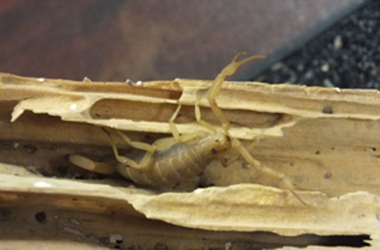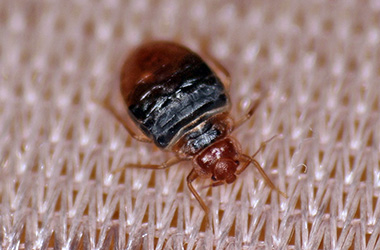
One of the most infamous of pests, the scorpion is one of the most difficult to eliminate. They spend most of their time tucked away in cracks or crevices and are even found in children’s sand boxes.
One of the most infamous of pests, the scorpion is one of the most difficult to eliminate. They spend most of their time tucked away in cracks or crevices and are even found in children’s sand boxes. Although scorpions are not aggressive hunters, their sting can be quite painful and in the case of one species found in the U.S., it can sometimes be fatal. The most venomous scorpion in North America, Centriroides exilicauda, is commonly referred to as the Arizona bark scorpion. As one of the smaller species of scorpion, an adult male can grow up to eight centimeters long, yellow to yellow-brown in color, with a long slender tail. It is found throughout the desert Southwest including Arizona (where it was first discovered in Tempe in 1927), western New Mexico, northern Mexico, and the west bank of the Colorado River in California.
Altogether, more than 30 species of scorpions are found in the southern and western United States, including scorpions common to New Mexicans such as the striped scorpion and the Desert Hairy scorpion. While these non-threatening species can inflict a painful sting, serums are available to relieve the more severe symptoms.
Because scorpions normally move about on the tips of their eight legs, with their bodies seldom touching the surface, they are among the most difficult of pests to control,. As a result, many pesticides are not as effective, since most common pesticides depend on physical contact with the animal’s body. One effective way to eliminate them is to remove their food supply, but it can take time for that approach to work.
Scorpions feed on insects, so effective scorpion control is dependent on a more complete pest control program. Since they can survive for weeks without food, and will resort to cannibalism when there is no other source, one of the most effective ways to eliminate scorpions is to physically remove them, one by one, usually at night when they are active. Fortunately, their bodies glow under a black light, so they are relatively easy to spot in the dark.
By the time you see scorpions in the open, you probably already have a serious infestation. For that reason, homeowners should be alert to more subtle signs of scorpions, which can include the sudden, unexplained disappearance of other insects, or finding insect body parts piled neatly in remote corners.
Most of all, be advised that scorpions are sedentary and prefer the most humid available locations. Being aware of areas conducive to a scorpion infestation is also important in preventing them from getting comfortable. Such areas include:
About Scott Svenheim and Truly Nolen
Scott Svenheim, an expert for Truly Nolen of America and Associate Certified Entomologist, has 27 years of experience in the pest control industry. Scott brings an informative as well as unique and entertaining perspective to consumers’ pest problems in the 21st century. Founded in 1938, Tucson, Arizona-based Truly Nolen of America is the largest family owned pest control company in the United States. Truly Nolen has over 80 branch offices in Arizona, California, Florida, Nevada, New Mexico, Texas and Utah. The company also has independently owned and operated franchises in an ever-growing number of territories including Kentucky, Georgia, New Jersey, Canada, Puerto Rico and 55 countries. For more information, please visit www.trulynolen.com.

One of the most infamous of pests, the scorpion is one of the most difficult to eliminate. They spend most of their time tucked away in cracks or crevices and are even found in children’s sand boxes.

What does the ever-changing weather patterns have to do with pest control? Quite a bit, actually.

In the past month, many residents in Las Vegas, Nevada, noticed small scorpions in their homes, specifically in beds, shoes, garages and near pets’ water bowls.